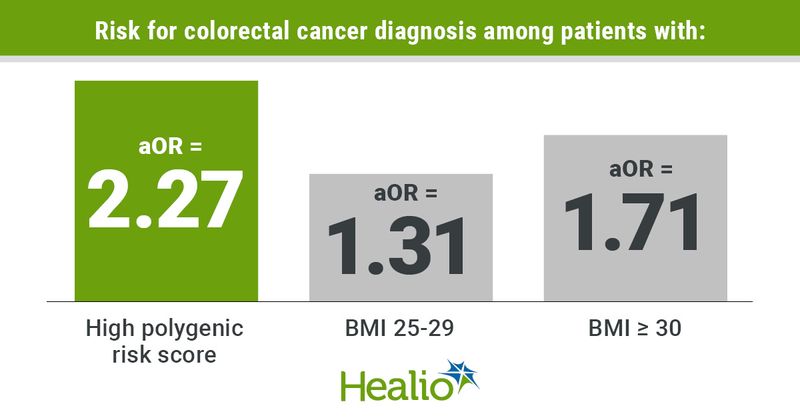Excess weight increased risk for colorectal cancer, independent of genetic risk
Click Here to Manage Email Alerts
Excess weight, regardless of polygenic risk score, correlated with an increased risk for colorectal cancer, according to results from a population-based, case-control study.
“Accumulated evidence has shown that a high BMI, as a proxy for excess body weight, is associated with increased CRC risk,” Xuechen Chen, MMed, of the division of clinical epidemiology and aging research at the German Cancer Research Center, and colleagues wrote in JAMA Network Open. “Polygenic risk scores (PRSs), the combination of multiple single nucleotide variations identified in genome-wide association studies, are increasingly used for CRC risk stratification and also are useful to improve limited statistical power in gene-environmental studies that often suffer from weak effects of single risk loci and harsh penalty of multiple comparison corrections.

“Another important issue is that CRC risks associated with excess weight and genetic risk factors are often evaluated separately, and how to communicate CRC risk increased by excess weight compared with the risk associated with background genetic profiles remains to be solved.”
To evaluate both individual and joint associations between BMI and PRSs with CRC, Chen and colleagues evaluated 9,169 participants (median age, 69 years; 61% men), of whom 5,053 had CRC and 4,116 were controls. Study analysis showed PRS and BMI independently associated with risk for CRC.
Compared with the lowest tertile, having a PRS in the top tertile correlated with “significantly increased” odds for a CRC diagnosis (adjusted OR = 2.27; 95% CI, 2.02-2.55), as did a BMI of 25 to 29 (aOR = 1.31; 95% CI, 1.18-1.46) and a BMI of 30 or greater (aOR = 1.71; 95% CI, 1.49-1.97) approximately 10 years prior to diagnosis compared with normal weight.
The risk for CRC increased among individuals with a BMI of 30 or more with low (adjusted OR = 1.97; 95% CI, 1.53-2.56), medium (aOR = 2.79; 95% CI, 2.19-3.56) or high PRSs (aOR = 3.82; 95% CI, 3.03-4.83) compared with individuals who with normal weight and low PRS. Further, those with a high PRS had increased risk for CRC with increasing BMI (<25: aOR = 2.41; 95% CI, 1.98-2.93; 25 to <30: aOR = 3.14; 95% CI, 2.6-3.79 and 30: aOR = 3.82; 95% CI, 3.03-4.82) compared with those who had a low PRS and normal weight.
Researchers estimated that the association between a BMI greater than 30 and the risk for CRC was “equivalent” to having a 41-percentile (95% CI, 29-53) higher PRS. Additionally, researchers noted a BMI of at least 30 had the greatest correlation with stage IV CRC (aOR = 2.21; 95% CI, 1.71-2.84).
“The findings of this case-control study add to the limited evidence on the individual and joint associations of BMI and PRS with CRC,” Chen and colleagues concluded. “The absence of interaction on a multiplicative scale between PRS and BMI, two significant CRC risk factors, provides a great potential for CRC risk classification through their joint consideration, and also underlines the importance of keeping a healthy weight.”
Editor's Note: On Jan. 19, 2023, the headline was changed to better reflect the findings of the study.

